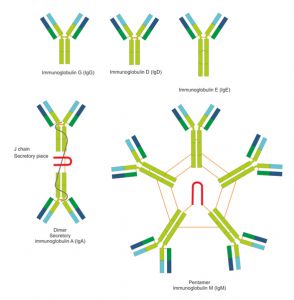
We are now just beginning the cold & flu season, and it is crucial to support the health of the immune system this time of year. The cold & flu season has been an annual phenomenon for centuries. Hippocrates, the father of medicine, noted the seasonal nature of highly infectious respiratory diseases in the “Book of Epidemics” in 400 BC.1
In modern times, the estimated costs for the common cold in the US are $40 billion per year. Influenza costs are an astounding $87 billion each year in the US, which highlights the colossal scope of the cold & flu season.1
Two of the newest viruses, SARS-CoV and SARS-CoV-2, emerged during the winter months since the winter environment promotes the spread of several respiratory viral infections. Human respiratory syncytial virus (RSV), influenza, and human coronaviruses are some of the most common underlying causes of seasonal respiratory tract infections.1 Continue reading below to learn more about the natural shield against viruses – Secretory IgA!
The Mucosal Immune System
The moist tissues that line the nasal passages, sinuses, mouth, and throat are known as mucosal surfaces. Since these surfaces are exposed to the outside world, they have a robust mucosal immune system to protect them. Every time you take a breath, your airways are exposed to innumerable and invisible toxins, allergens, and pathogens. If mucosal immunity is not optimal, respiratory viruses can quickly invade the body, causing infection and dysfunction.2
One of the first lines of defense against viruses is an extraordinary and specialized antibody known as Secretory IgA (sIgA) that is naturally produced by the mucosal immune system.

What is Secretory IgA (sIgA)?
Secretory Immunoglobulin A, also known as Secretory IgA or sIgA, is a specialized antibody that can function outside the body on mucosal surfaces. IgA was first discovered in 1953 and is the most abundant immunoglobulin produced along the mucosal surfaces.3 Studies show approximately 74% of all mucosal antibodies are IgA antibodies.2
Immunoglobulin A (IgA) is one antibody isotype produced by the immune system. Other antibody isotypes include IgG, IgD, IgE, and IgM. To produce secretory IgA, two IgA molecules are linked together along with a secretory component. More IgA antibodies are produced daily than the total amount of all other antibody isotypes combined.2 Here is a picture of the structure of the different isotypes of antibodies:

Secretory IgA is considered a protective and anti-inflammatory antibody, while other antibodies primarily have an inflammatory effect. For example, when an IgG antibody interacts with a pathogen, it has the ability to kill it, which sounds beneficial, but this process can cause a high level of inflammation that damages cells and tissues.4 Secretory IgA antibodies prevent infections by other mechanisms that minimize inflammation and damage.
Because of its unique immunosuppressive and immunomodulatory capabilities, sIgA helps to maintain homeostasis at the mucosal barrier. Maintaining a balance in inflammatory and anti-inflammatory activity is a challenge since the mucosal surfaces are permanently exposed to an enormous variety of both harmful and harmless organisms, compounds, and molecules. More research has been performed on the protective activities of sIgA in the gut than in the airways. However, similar mechanisms are likely to occur in the respiratory mucosal tissues to maintain health during the cold & flu season.5

How does sIgA offer Protection from Cold & Flu Viruses?
Technically, sIgA begins to protect health in infancy since it is the predominant immunoglobulin present in breastmilk. In infants, sIgA in natural breast milk protects against acute infections but also supports lifelong health. Research shows a lack of sIgA in early life due to being formula-fed rather than breastfed may increase the risk of developing inflammatory bowel disease (IBD), obesity, allergies, and autoimmune disorders, including asthma.3
Secretory IgA and the mucosal immune system also play a starring role during every cold and flu season. The total surface area of the respiratory and digestive tracts is approximately 200 times larger than that of the skin. Approximately 60–70% of white blood cells reside in the mucosal tissues to protect them since the mucosal surfaces are incessantly exposed to microorganisms, allergens, and toxins from the outside world.4 Secretory IgA binds to the mucus layer that covers and protects the mucosal surfaces.5

In the gut, research shows sIgA protects the mucosal tissues in at least three different ways:
- Secretory IgA neutralizes pathogens, including viruses
- Secretory IgA develops the composition of the beneficial commensal microbiota
- Secretory IgA prevents harmful inflammatory responses to pathogens, foods, and other substances that interact with the mucosal surfaces.5
When present in mucosal secretions, sIgA molecules bind to infectious pathogens, thus preventing their adhesion and entrance into the body. The binding of sIgA molecules to these pathogens then facilitates their elimination. Preventing the adhesion and adsorption of pathogenic organisms while also facilitating their removal is a phenomenon known as “immune exclusion.” Two additional methods by which sIgA molecules reduce the likelihood of viral infections include direct interference with surface receptor binding and a reduction in the activation and expression of pathogenic virulence factors.6
So, sIgA is able to eliminate viruses (and other pathogens) via immune exclusion before they enter the body and neutralize intracellular viruses.5

Evidence that Supporting sIgA Production is Beneficial during the Cold & Flu Season
Research shows active infection with cold & flu viruses, including influenza, rhinovirus, and coronavirus, elicits an increase in sIgA production along the nasal mucosae. Also, animal studies have demonstrated that nasal sIgA directly protects against infection with influenza.5
Evidence from studying endurance athletes also supports the powerful role sIgA plays in preventing upper respiratory viral infections. Research shows strenuous exercise, a stressor, decreases sIgA production, which then leads to increased upper respiratory viral infections in elite athletes.5
Selective IgA Deficiency (SIgAD) is a genetic condition characterized by an inability to produce IgA and sIgA. Since individuals with SIgAD cannot produce sIgA, they offer an opportunity to assess the effects of low sIgA production. Epidemiological studies show recurrent infections of the respiratory system are the most common finding in patients with SIgAD. Not all patients with SIgAD experience increased infections, though. Researchers speculate that some of these patients have increased production of sIgM antibodies to adapt to the absence of sIgA.5
Are you and your patients adequately protected in preparation for this cold & flu season? Have you tested your sIgA level?

Secretory IgA (sIgA) Testing
Secretory IgA (sIgA) is a measurable biomarker that reflects the resilience of the mucosal immune response. Secretory IgA is synthesized by activated B cells along the mucosal membranes in the mouth, sinuses, eyes, throat, lungs, gastrointestinal tract, and genitourinary tract. Since these mucosal surfaces are exposed to the outside world, sIgA is considered to be an important part of the first line of immune defense against the pathogens that cause infections – including cold & flu viruses.6
The total salivary sIgA level generally mirrors the sIgA level in other mucosal tissues (e.g., lungs) and is an expedient tool to monitor changes in mucosal immune status.6 Intestinal sIgA directly assesses sIgA production in the GI tract. Get your patients ready for the cold & flu season by testing and optimizing their sIgA level.

Treatment Options to Boost sIgA Production
Evidence shows these supportive options help maintain the optimal production of sIgA*:
- Probiotics7-9
- Lactobacillus spp.10-15
- Bifidobacterium spp.16-19
- Saccharomyces boulardii20
- Prebiotics21-24
- Colostrum25,26
- Thymus glandular27
- Nutritional Immune support
- Herbal Immune Support
- Turmeric36,37
- Medicinal mushrooms36,38-42
- Astragalus41,43
- Echinacea44
- Ginseng45
- Shosaiko-to46
- Fucoidan47
- Chlorella48,49
- Aloe vera gel50
- Elderberry9
- Stress Management51-54
- Adaptogens such as Ginseng, Ashwagandha, and Eleuthero45,46,55,56
- GABA57,58
- Glycine59
- Passiflora spp.60,61
- Meditation62,63
- Therapy/companion dog64
- Forest bathing65
- Biofeedback66
- Expression of anger67
- Participation in musical activity68
- Listening to music69,70
- Daily relaxation routine71
- Amino Acids
- N-acetylcysteine72
- Glutamine73,74
- Arginine75-77
- L-tryptophan78
- Leucine79
- Taurine80
- Exercise
- Regular moderate aerobic exercise81,82
- Resistance training83,84
- Acupuncture85,86
- Optimize blood glucose management and HbA1c level87
- Pre-germinated brown rice88
- Intermittent fasting89
Total Salivary Secretory IgA (sIgA) can be ordered as part of an:
Total Intestinal Secretory IgA (sIgA) can be ordered as part of a:
- Gastrointestinal Health Panel
- Expanded Gastrointestinal Health Panel
- Calprotectin Plus Panel
- Customized Flexi-Matrix panel
Total Intestinal sIgA and Total Salivary sIgA can also be ordered as single tests.
To place a test order, click here. As a reminder, DiagnosTechs will drop ship test kits directly to your patients. You may select this option at the top of the order form.
Please visit our Provider Tools page for more information about choosing the right test and mucosal immunity.
* This statement has not been evaluated by the Food and Drug Administration. These products are not intended to diagnose, treat, cure or prevent any disease.
YOU MAY ALSO ENJOY
POSTBIOTICS AND INTESTINAL PERMEABILITY (LEAKY GUT SYNDROME)
Hippocrates, the Greek physician regarded as the “Father of Medicine,” is well known for his proclamation that “all disease begins in the gut” over two thousand years ago. Now, in 2023, we know his astute instinct was likely correct as we continue to learn how the gut microbiome and the numerous compounds it produces play a critical role in the prevention of many chronic diseases.
April is Stress Awareness Month, so let’s learn more about the stress hormone known as cortisol! While cortisol is known as the stress hormone, it is crucial for the optimal function of your body every day. In healthy individuals, cortisol levels naturally shift throughout the day in a pattern known as a diurnal rhythm.
POSTBIOTICS – THE NATURAL ANTIVIRALS OF THE FUTURE?
Microbial medicine has significantly evolved in recent years, and we now know nourishing the microbiome is a potential treatment option and prevention strategy for many health concerns. Microbial communities are found in many areas within the human body, including the gut, skin, lungs, sinuses, mouth, and urinary tract. The gut microbiome and its metabolites, in particular, play a fundamental role in many bodily functions, including nutrient production, nutrient absorption, immune system regulation, and the defense against infections, including viral infections.
NATURAL IMMUNE SUPPORT FOR THE COLD AND FLU SEASON
The common cold is the most frequent human illness. Genetics, stress, smoking, nutrient deficiencies, and strenuous physical training can increase the risk of catching a cold. Modern research now confirms that supplemental vitamins, minerals, botanicals, and other natural remedies can decrease the severity and duration of the common cold.
References:
- Moriyama M, Hugentobler WJ, Iwasaki A. Seasonality of Respiratory Viral Infections. Annu Rev Virol. 2020;7(1):83-101. doi:10.1146/annurev-virology-012420-022445
- Bohländer F. A new hope? Possibilities of therapeutic IgA antibodies in the treatment of inflammatory lung diseases. Front Immunol. 2023;14:1127339. doi:10.3389/fimmu.2023.1127339
- Guo J, Ren C, Han X, et al. Role of IgA in the early-life establishment of the gut microbiota and immunity: Implications for constructing a healthy start. Gut Microbes. 2021;13(1):1-21. doi:10.1080/19490976.2021.1908101
- Kurono Y. The mucosal immune system of the upper respiratory tract and recent progress in mucosal vaccines. Auris Nasus Larynx. 2022;49(1):1-10. doi:10.1016/j.anl.2021.07.003
- Sánchez Montalvo A, Gohy S, Rombaux P, et al. The Role of IgA in Chronic Upper Airway Disease: Friend or Foe?. Front Allergy. 2022;3:852546. doi:10.3389/falgy.2022.852546
- Assessing the impact of stress on the immune system. DiagnosTechs, Inc. May 9, 2020. Accessed August 14, 2023. https://www.diagnostechs.com/2020/03/30/30570/.
- Tremblay A, Xu X, Colee J, Tompkins TA. Efficacy of a Multi-Strain Probiotic Formulation in Pediatric Populations: A Comprehensive Review of Clinical Studies. Nutrients. 2021;13(6):1908. doi:10.3390/nu13061908
- Xiao L, Gong C, Ding Y, et al. Probiotics maintain intestinal secretory immunoglobulin A levels in healthy formula-fed infants: a randomised, double-blind, placebo-controlled study. Benef Microbes. 2019;10(7):729-739. doi:10.3920/BM2019.0025
- Coman MM, Micioni Di Bonaventura MV, et al. SYNBIO® Probiotic and Antioxidant Dietary Supplementation: Clinical Trial Evaluation of Potential Effects on Airline Flight Crew Members’ Well-Being. Microorganisms. 2023;11(4):924. doi:10.3390/microorganisms11040924
- Lara-Villoslada F, Sierra S, Boza J, et al. [Beneficial effects of consumption of a dairy product containing two probiotic strains, Lactobacillus coryniformis CECT5711 and Lactobacillus gasseri CECT5714 in healthy children]. Nutr Hosp. 2007;22:496-502.
- Gleeson M, Bishop NC, Oliveira M, Tauler P. Daily probiotic’s (Lactobacillus casei Shirota) reduction of infection incidence in athletes. Int J Sport Nutr Exerc Metab. 2011;21(1):55-64.
- Kusumo P, Bela B, Wibowo H, et al. Lactobacillus plantarum IS-10506 supplementation increases faecal sIgA and immune response in children younger than two years. Benef Microbes. 2019;10(3):245-252.
- Zhang J, Deng J, Wang Z, et al. Modulatory effects of Lactobacillus salivarius on intestinal mucosal immunity of piglets. Curr Microbiol. 2011;62(5):1623-31.
- Pahumunto N, Sophatha B, Piwat S, et al. Increasing salivary IgA and reducing Streptococcus mutans by probiotic Lactobacillus paracasei SD1: A double-blind, randomized, controlled study. J Dent Sci. 2019; 14(2):178-184.
- Garcia-Castillo V, Komatsu R, Clua P, et al. Evaluation of the Immunomodulatory Activities of the Probiotic Strain Lactobacillus fermentum UCO-979C. Front Immunol. 2019;10:1376.
- Azad MAK, Sarker M, Wan D. Immunomodulatory Effects of Probiotics on Cytokine Profiles. Biomed Res Int. 2018;2018:8063647. doi:10.1155/2018/8063647
- Takahashi T, Nakagawa E, Nara T, et al. Effects of orally ingested Bifidobacterium longum on the mucosal IgA response of mice to dietary antigens. Biosci Biotechnol Biochem. 1998;62(1):10-5.
- Mohan R, Koebnick C, Schildt J, et al. Effects of Bifidobacterium lactis Bb12 supplementation on body weight, fecal pH, acetate, lactate, calprotectin, and IgA in preterm infants. Pediatr Res. 2008;64(4):418-22.
- Terahara M, Nakamura Y, Tsuboi M, et al. Effects of the intake of non-live Bifidobacterium bifidum on the faecal IgA of full-term infants: a double-blind, randomised, placebo-controlled study. Biosci Microbiota Food Health. 2021;40(4):196-203. doi:10.12938/bmfh.2021-018
- Rajput I, Ying H, Yajing S, et al. Saccharomyces boulardii and Bacillus subtilis B10 modulate TLRs and cytokines expression patterns in jejunum and ileum of broilers. PLoS One. 2017;12(3):e0173917.
- Bakker-Zierikzee AM, Tol EA, Kroes H, et al. Faecal SIgA secretion in infants fed on pre- or probiotic infant formula. Pediatr Allergy Immunol. 2006;17(2):134-40.
- Zhu W, Zhou S, Liu J, e al. Prebiotic, immuno-stimulating and gut microbiota-modulating effects of Lycium barbarum polysaccharide. Biomed Pharmacother. 2020;121:109591.
- Zhang S, Hu H, He W, et al. Regulatory Roles of Pectin Oligosaccharides on Immunoglobulin Production in Healthy Mice Mediated by Gut Microbiota. Mol Nutr Food Res. 2019;63(14):e1801363. doi:10.1002/mnfr.201801363
- Wu W, Zhang L, Xia B, et al. Modulation of Pectin on Mucosal Innate Immune Function in Pigs Mediated by Gut Microbiota. Microorganisms. 2020;8(4):535. doi:10.3390/microorganisms8040535
- Matsukawa S, Ueno K, Sugino T, et al. Effects of colostrum whey on immune function in the digestive tract of goats. Anim Sci J. 2018;89(8):1152-1160.
- Glass KM, Greecher C, and Doheny K. Oropharyngeal Administration of Colostrum Increases Salivary Secretory IgA Levels in Very Low-Birth-Weight Infants. Am J Perinatol. 2017;34(14):1389-1395.
- Fiocchi A, Borella E, Riva E, et al. A double-blind clinical trial for the evaluation of the therapeutical effectiveness of a calf thymus derivative (Thymomodulin) in children with recurrent respiratory infections. Thymus. 1986;8(6):331-339.
- Xu C, Sun R, and Qiao X. Effect of vitamin e supplementation on intestinal barrier function in rats exposed to high altitude hypoxia environment. Korean J Physiol Pharmacol. 2014;18(4):313-20.
- Muir W, Husband A, and Bryden W. Dietary supplementation with vitamin E modulates avian intestinal immunity. Br J Nutr. 2002;87(6):579-85.
- Lyu Y, Wu L, Wang F, et al. Carotenoid supplementation and retinoic acid in immunoglobulin A regulation of the gut microbiota dysbiosis. Exp Biol Med (Maywood). 2018;243(7):613-620.
- Scott J, Kazman J, Palmer J, et al. Effects of vitamin D supplementation on salivary immune responses during Marine Corps basic training. Scand J Med Sci Sports. 2019;29(9):1322-1330.
- Gan L, Fan H, Mahmood T, Guo Y. Dietary supplementation with vitamin C ameliorates the adverse effects of Salmonella Enteritidis-challenge in broilers by shaping intestinal microbiota. Poult Sci. 2020;99(7):3663-3674. doi:10.1016/j.psj.2020.03.062
- Bortoluzzi C, Lumpkins B, Mathis GF, et al. Zinc source modulates intestinal inflammation and intestinal integrity of broiler chickens challenged with coccidia and Clostridium perfringens. Poult Sci. 2019;98(5):2211-2219.
- Levkut M, Levkutová M, Grešáková Ľ, et al. Production of Intestinal Mucins, sIgA, and Metallothionein after Administration of Zinc and Infection of Ascaridia galli in Chickens: Preliminary Data. Life (Basel). 2022;13(1):67. doi:10.3390/life13010067
- Dalia A, Loh T, Sazili A, et al. Effects of vitamin E, inorganic selenium, bacterial organic selenium, and their combinations on immunity response in broiler chickens. BMC Vet Res. 2018;14(1):249.
- Kim S, Lee S, Nam S, et al. Turmeric Bioprocessed with Mycelia from the Shiitake Culinary-Medicinal Mushroom Lentinus edodes (Agaricomycetes) Protects Mice Against Salmonellosis. Int J Med Mushrooms. 2017;19(4):363-376.
- Okazaki Y, Han Y, Kayahara M, et al. Consumption of curcumin elevates fecal immunoglobulin A, an index of intestinal immune function, in rats fed a high-fat diet. J Nutr Sci Vitaminol. 2010;56(1):68-71.
- Kubota A, Kobayashi M, Sarashina S, et al. Reishi mushroom Ganoderma lucidum Modulates IgA production and alpha-defensin expression in the rat small intestine. J Ethnopharmacol. 2018;214:240-243.
- Jeong S, Koyyalamudi S, and Pang G. Dietary intake of Agaricus bisporus white button mushroom accelerates salivary immunoglobulin A secretion in healthy volunteers. 2012;28(5):527-31.
- Dai X, Stanilka JM, Rowe CA, et al. Consuming Lentinula edodes (Shiitake) Mushrooms Daily Improves Human Immunity: A Randomized Dietary Intervention in Healthy Young Adults. J Am Coll Nutr. 2015;34(6):478-87.
- Guo FC, Kwakkel RP, Williams BA, et al. Effects of mushroom and herb polysaccharides on cellular and humoral immune responses of Eimeria tenella-infected chickens. Poult Sci. 2004;83(7):1124-32.
- Chen S, Wang J, Dong N, et al. Polysaccharides from natural Cordyceps sinensis attenuated dextran sodium sulfate-induced colitis in C57BL/6J mice. Food Funct. 2023;14(2):720-733. doi:10.1039/d2fo02555h
- Ruili Z, Qun Y, Guangliang S, et al. chTLR4 pathway activation by Astragalus polysaccharide in bursa of Fabricius. BMC Vet Res. 2017;13:119.
- Davison G, Kehaya C, and Jones A. Nutritional and Physical Activity Interventions to Improve Immunity. Am J Lifestyle Med. 2014;10(3):152–169.
- Park H, Lee S, Lee K, et al. Ginsenoside Rg1 and 20(S)-Rg3 Induce IgA Production by Mouse B Cells. Immune Netw. 2015;15(6):331-6.
- Tauchi Y, Yamada A, Kawakita T, et al. Enhancement of immunoglobulin A production in Peyer’s patches by oral administration of a traditional Chinese medicine, xiao-chai-hu-tang (Shosaiko-to). Immunopharmacol Immunotoxicol. 1993;15(2-3):251-72.
- Katayama S, Nishio T, Kishimura H, et al. Immunomodulatory Properties of Highly Viscous Polysaccharide Extract from the Gagome Alga (Kjellmaniella crassifolia). Plant Foods for Human Nutrition. 2012;67:76–81.
- Chidley C and Davison G. The effect of Chlorella pyrenoidosa supplementation on immune responses to 2 days of intensified training. Eur J Nutr. 2018;57(7):2529–2536.
- Otsuki T, Shimizu K, Lemitsu M, et al. Chlorella intake attenuates reduced salivary SIgA secretion in kendo training camp participants. Nutr J. 2012;11:103.
- Im S, Kim K, Kim H, et al. Processed Aloe vera gel ameliorates cyclophosphamide-induced immunotoxicity. Int J Mol Sci. 2014;15(11):19342-54.
- Phillips AC, Carroll D, Evans P, et al. Stressful life events are associated with low secretion rates of immunoglobulin A in saliva in the middle aged and elderly. Brain Behav Immun. 2006;20(2):191-7.
- Hanstock H, Edwards J, Roberts R, et al. High heart rate reactors display greater decreases in tear SIgA concentration following a novel acute stressor. Biol Psychol. 2018;133:85-88.
- Engeland C, Hugo F, Hilgert J, et al. Psychological distress and salivary secretory immunity. Brain Behav Immun. 2016;52:11-17.
- Staley M, Conners M, Hall K, et al. Linking Stress and Immunity: Immunoglobulin A as a Non-Invasive Physiological Biomarker in Animal Welfare Studies. Horm Behav. 2018;102:55-68.
- Yamada K, Hung P, Kyu Park T, et al. A Comparison of the Immunostimulatory Effects of the Medicinal Herbs Echinacea, Ashwagandha and Brahmi. J Ethnopharmacol. 2011;137(1):231-5
- Huang D, Ran R, Yu Z. Effect of Acanthopanax senticosus injection on the activities of human tumor necrosis factor and natural killer cell in blood in the patients with lung cancer. Zhongguo Zhong Yao Za Zhi. 2005;30(8):621-4.
- Abdou AM, Higashiguchi S, Horie K, et al. Relaxation and immunity enhancement effects of gamma-aminobutyric acid (GABA) administration in humans. 2006;26:201-8.
- Zhao Y, Wang J, Wang H, et al. Effects of GABA Supplementation on Intestinal SIgA Secretion and Gut Microbiota in the Healthy and ETEC-Infected Weanling Piglets. Mediators Inflamm. 2020;2020:7368483. doi:10.1155/2020/7368483
- Jarosz L, Marek A, Gradzki Z, et al. Effect of Feed Supplementation With Zinc Glycine Chelate and Zinc Sulfate on Cytokine and Immunoglobulin Gene Expression Profiles in Chicken Intestinal Tissue. Poult Sci. 2017;96(12):4224-4235.
- Jawna-Zboińska K, Blecharz-Klin K, Joniec-Maciejak I, et al. Passiflora incarnata L. Improves Spatial Memory, Reduces Stress, and Affects Neurotransmission in Rats. Phytother Res. 2016;30(5):781-789. doi:10.1002/ptr.5578
- Aslanargun P, Cuvas O, Dikmen B, et al. Passiflora Incarnata Linneaus as an Anxiolytic Before Spinal Anesthesia. J Anesth. 2012;26(1):39-44.
- Goyal M, Singh S, Sibinga E, et al. Meditation Programs for Psychological Stress and Well-Being: A Systematic Review and Meta-Analysis. JAMA Intern Med. 2014;174(3):357-68.
- Torkamani F, Aghayousefi A, Alipour A, et al. Effects of Single-Session Group Mantra-meditation on Salivary Immunoglobulin A and Affective State: A Psychoneuroimmunology Viewpoint. Explore (NY). 2018;14(2):114-121.
- Charnetski CJ, Riggers S, Brennan FX. Effect of petting a dog on immune system function. Psychol Rep. 2004;95:1087-91.
- Antonelli M, Barbieri G, Donelli D. Effects of forest bathing (shinrin-yoku) on levels of cortisol as a stress biomarker: a systematic review and meta-analysis. International Journal of Biometeorology. 2019;63(8):1117-1134.
- Goessl V, Curtiss J, Hofmann S. The effect of heart rate variability biofeedback training on stress and anxiety: a meta-analysis. Psychol Med. 2017;47(15):2578-2586.
- Romero-Martínez A, Lila M Vitoria-Estruch S, et al. High Immunoglobulin A Levels Mediate the Association Between High Anger Expression and Low Somatic Symptoms in Intimate Partner Violence Perpetrators. J Interpers Violence. 2016;31(4):732-42.
- Kuhn D. The Effects of Active and Passive Participation in Musical Activity on the Immune System as Measured by Salivary Immunoglobulin A (SIgA). J Music Ther. 2002;39(1):30-9.
- Fancourt D, Ockelford A, Belai A. The psychoneuroimmunological effects of music: a systematic review and a new model. Brain Behav Immun. 2014;36:15-26.
- Hucklebridge F, Lambert S, Clow A, et al. Modulation of secretory immunoglobulin A in saliva; response to manipulation of mood. Biol Psychol. 2000;53(1):25-35.
- Green M, Green R, Santoro W, et al. Daily Relaxation Modifies Serum and Salivary Immunoglobulins and Psychophysiologic Symptom Severity. Biofeedback Self Regul. 1988;13(3):187-99
- Kalyuzhin O. Effect of N-acetylcysteine on mucosal immunity of respiratory tract. Ter Arkh. 2018;90(3):89-95.
- Perna S, Alalwan T, Alaali Z, et al. The Role of Glutamine in the Complex Interaction between Gut Microbiota and Health: A Narrative Review. Int J Mol Sci. 2019;20(20):5232.
- Wu M, Xiao H, Liu G, et al. Glutamine promotes intestinal SIgA secretion through intestinal microbiota and IL-13. Mol Nutr Food Res. 2016;60(7):1637-48.
- Wu M, Xiao H, Shao F, Tan B, Hu S. Arginine accelerates intestinal health through cytokines and intestinal microbiota. Int Immunopharmacol. 2020;81:106029. doi:10.1016/j.intimp.2019.106029
- Ren W, Chen S, Yin J, et al. Dietary arginine supplementation of mice alters the microbial population and activates intestinal innate immunity. J Nutr. 2014;144(6):988-95.
- Ruan D, Fouad AM, Fan QL, et al. Dietary L-arginine supplementation enhances growth performance, intestinal antioxidative capacity, immunity and modulates gut microbiota in yellow-feathered chickens. Poult Sci. 2020;99(12):6935-6945. doi:10.1016/j.psj.2020.09.042
- Liang H, Dai Z, Kou J, et al. Dietary l-Tryptophan Supplementation Enhances the Intestinal Mucosal Barrier Function in Weaned Piglets: Implication of Tryptophan-Metabolizing Microbiota. Int J Mol Sci. 2018;20(1):20.
- Song B, Zheng C, Zha C, et al. Dietary leucine supplementation improves intestinal health of mice through intestinal SIgA secretion. J Appl Microbiol. 2020;128(2):574-583. doi:10.1111/jam.14464
- Xu M, Che L, Gao K, et al. Effects of Dietary Taurine Supplementation to Gilts during Late Gestation and Lactation on Offspring Growth and Oxidative Stress. Animals (Basel). 2019;9(5):220. doi:10.3390/ani9050220
- Martins R, Cunha M, Neves A, et al. Effects of aerobic conditioning on salivary IgA and plasma IgA, IgG and IgM in older men and women. Int J Sports Med. 2009;30(12):906-12.
- Drago-Serrano M, Godínez-Victoria M, Lara-Padilla E, et al. Moderate exercise enhances expression of SIgA in mouse ileum. Int J Sports Med. 2012;33(12):1020-5.
- Fornieles G, Rosety M, Elosegui S, et al. Salivary testosterone and immunoglobulin A were increased by resistance training in adults with Down syndrome. Braz J Med Biol Res. 2014;47(4):345-8.
- Hwang Y, Park J, Lim K. Effects of Pilates Exercise on Salivary Secretory Immunoglobulin A Levels in Older Women. J Aging Phys Act. 2016;24(3):399-406.
- Yang MM, Ng KK, Zeng HL, et al. Effect of acupuncture on immunoglobulins of serum, saliva and gingival sulcus fluid. Am J Chin Med. 1989;17(1-2):89-94.
- Hideaki W, Tatsuya H, Shogo M, et al. Effect of 100 Hz electroacupuncture on salivary immunoglobulin A and the autonomic nervous system. Acupunct Med. 2015;33(6):451-6.
- Oikawa J, Ukawa S, Ohira H, et al. Diabetes Mellitus is Associated With Low Secretion Rates of Immunoglobulin A in Saliva. J Epidemiol. 2015;25(7):470-4.
- Sakamoto S, Hayashi T, Hayashi K, et al. Pre-germinated brown rice could enhance maternal mental health and immunity during lactation. Eur J Nutr. 2007;46:391-6.
- Godínez-Victoria M, Campos-Rodriguez R, Rivera-Aguilar V, et al. Intermittent fasting promotes bacterial clearance and intestinal IgA production in Salmonella typhimurium-infected mice. Scand J Immunol. 2014;79(5):315-24.

